 I think you’ll agree that trying to play on an out of tune guitar can be very discouraging and for those of you who have never tuned a guitar before the task can seem a bit overwhelming.
I think you’ll agree that trying to play on an out of tune guitar can be very discouraging and for those of you who have never tuned a guitar before the task can seem a bit overwhelming.
Well, no need to fret.
With a bit of understanding and knowledge anyone can learn how to tune a guitar.
My in depth guide to guitar tuning will show you exactly how to tune your guitar and keep it in tune, no matter what level of skill you’re at as a guitar player.
Improve your guitar playing by downloading a copy of my Free Guitar Practice Routine Checklist and Planning Guide.
Table of Contents
- Exposing The Truth Behind The Notes
- How To Sound Like Everyone Else: Standard Open String Tuning
- Tools Of The Trade: Tuning Machines
- The Key To Sounding Like Your Favorite Records: Concert Pitch
- Why You Will Never Be Able To Play In Tune: Even Tempered Scales
- The Members Of Your Team: Notes on the Fretboard
- Methods for Tuning the Guitar
- A New Perspective: Alternative Tunings
- Relieving Your Frustrations: Tuning Tips
- How To Remember Different Tunings
Exposing The Truth Behind The Notes
Before learning how to tune a guitar it is important to understand how your guitar strings produce sound and music.
When a guitar string is plucked it causes the string to vibrate.
This vibrating motion of the string produces sound waves in the air that eventually reach your ears and are perceived as specific notes.
What determines the pitch of these notes is the length, tension, and thickness of the guitar string.
The length of the guitar string is usually predetermined or can be adjusted in a process known as intonation.
The thickest strings on a six-string guitar produce the lowest notes and the thinnest strings produce the highest notes.
Adjusting the tension of the strings is how you change the pitch that the strings produce.
The process of increasing string tension or decreasing string tension is what is referred to as tuning the guitar.
How To Sound Like Everyone Else: Standard Open String Tuning
The standard way of tuning a six-string guitar is as follows, from thickest to thinnest string:
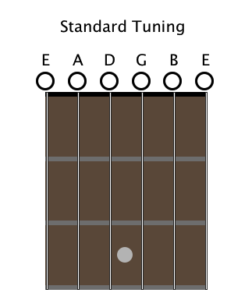
Tools of the Trade: Tuning Machines
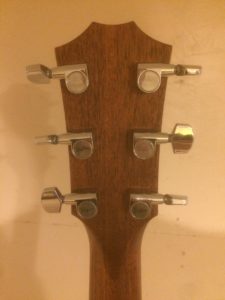 To increase or decrease the tension of the guitar strings, you use devices called tuning machines, which are installed on the headstock of the guitar.
To increase or decrease the tension of the guitar strings, you use devices called tuning machines, which are installed on the headstock of the guitar.
Tightening the tuning machines will cause an increase in tension of the guitar string, and loosening the tuning machines will cause a decrease in tension of the guitar string.
Tuning machines may also be referred to as “tuning heads” or “machine heads.”
The Key To Playing Along With Your Favourite Records: Concert Pitch
If you plan on playing guitar with other musicians, or if you want to develop a musical ear when playing the guitar, it’s important to make sure your guitar is tuned to concert pitch.
Concert pitch is the standardization of assigning specific notes to specific frequencies.
The frequency of a note is the number of cycles that its sound wave will go through in one second.
Frequency is measured in Hertz (Hz), which means cycles per second.
For an instrument to be tuned to standard pitch, the note A must have a frequency of 440 Hz. On a guitar this A is the 5th fret on the first string (the thinnest string).
This is the A just above middle C on a piano. To tune a guitar to concert pitch a reference note must be used.
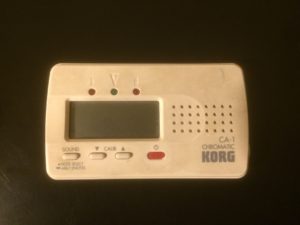
There are many ways to obtain a reference note such as electronic guitar tuners, tuning forks, or other instruments that are already tuned to concert pitch.
When using one of these reference notes, you adjust the tension of the string until it matches the pitch of the reference note.
For example, if you’re using the note E above middle C on a piano, you’d adjust the tension of the high E string until the open-string note (E) matches the note the piano is producing.
Why You Will Never Be Able to Tune Your Guitar: Even Tempered Scales
Because the guitar is an even-tempered instrument, it can never be perfectly in tune.
The fixed positions of the frets is a compromise when it comes to playing in tune; the guitar can’t be played perfectly in any key but can be played almost perfectly in many different keys.
The Members of Your Team: Notes on the Fretboard
Below is a diagram of all the notes on the fretboard of the guitar from the open string all the way to the 12th fret when the guitar is in standard tuning.
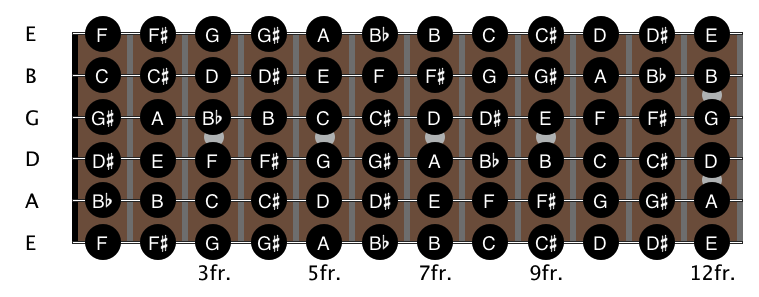
Methods for Tuning the Guitar
Now that you know how the guitar is tuned, you need to learn methods for actually tuning the instrument.
Most of the methods discussed below will allow the guitar to be tuned by itself, which is known as “relative tuning.”
When tuning a guitar with a relative tuning method, one of the strings of the guitar will be used as a reference pitch.
This allows you to tune a guitar sufficiently enough so you can play songs and have them sound accurate.
The downside is the strings may not be in an accurate key due to the lack of using a standard concert reference note.
If using a relative tuning method, and you want the guitar to be tuned to standard concert pitch, you must first tune one of the guitar strings to an accurate reference pitch.
Then, continue tuning the rest of the strings to that string by following one of the relative tuning methods laid out below.
Tuning a guitar accurately using a relative tuning method depends on your ability to hear slight differences in pitch between different notes.
The ability to recognize these differences in pitch is usually referred to as your musical “ear.”
Some people have a naturally good ear and can tune a guitar with ease, while others may find it a bit more difficult.
The good news is that your ear will develop the more you play and listen to music.
The more experience you gain as a musician, the better your musical ear will become.
When tuning the guitar, it’s important to take your time and listen very closely to the difference in pitch between the note you’re using as a reference pitch and the note you’re tuning.
The more relaxed you are, the better you’ll be able to focus on detecting whether a note is sharp or flat compared to the reference pitch.
Another trick to ensure accurate tuning is to tune up to pitch rather than down to pitch.
The reason for this is because strings have a tendency to get caught and slip in the nut slot.
If you tune down, it’s possible that the string will catch a snag in the nut slot when it slackens and then snap flat when you’re playing, due to bending the strings, a hard strum, etc.
When comparing the note you’re tuning to the reference note, and you notice that the note is sharp, loosen the string so the note falls a little flat, then tune back up to the reference pitch.
It’s a good idea to first perform a rough tuning of all six strings, and then a follow up fine-tuning after each string is approximately in tune.
Because strings will stretch, this allows them to settle into place before finalizing their tuning.
This’ll also allow you to put more focus into the small adjustments necessary when performing the fine-tuning.
Keeping It Together: Relative Tuning Methods
The relative tuning methods below show an arrow going from the intended reference pitch on one string to the note on the string meant for tuning.
Method 1 (5th Fret Method)
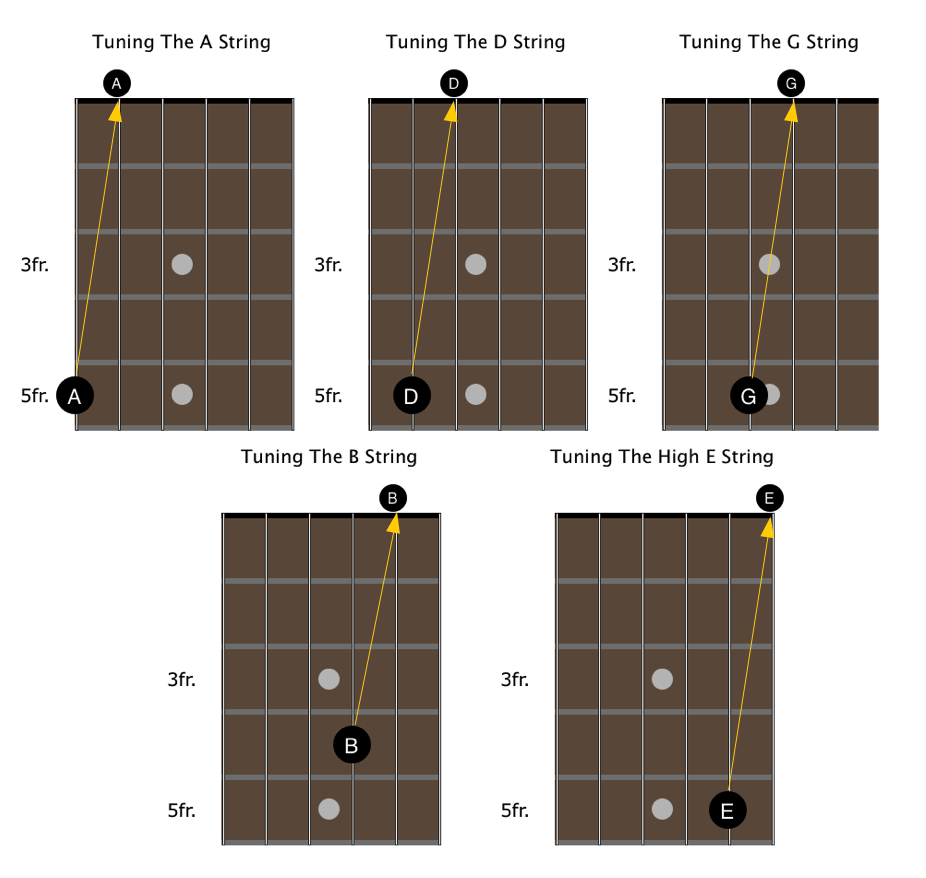
Method 2 (7th Fret Method)
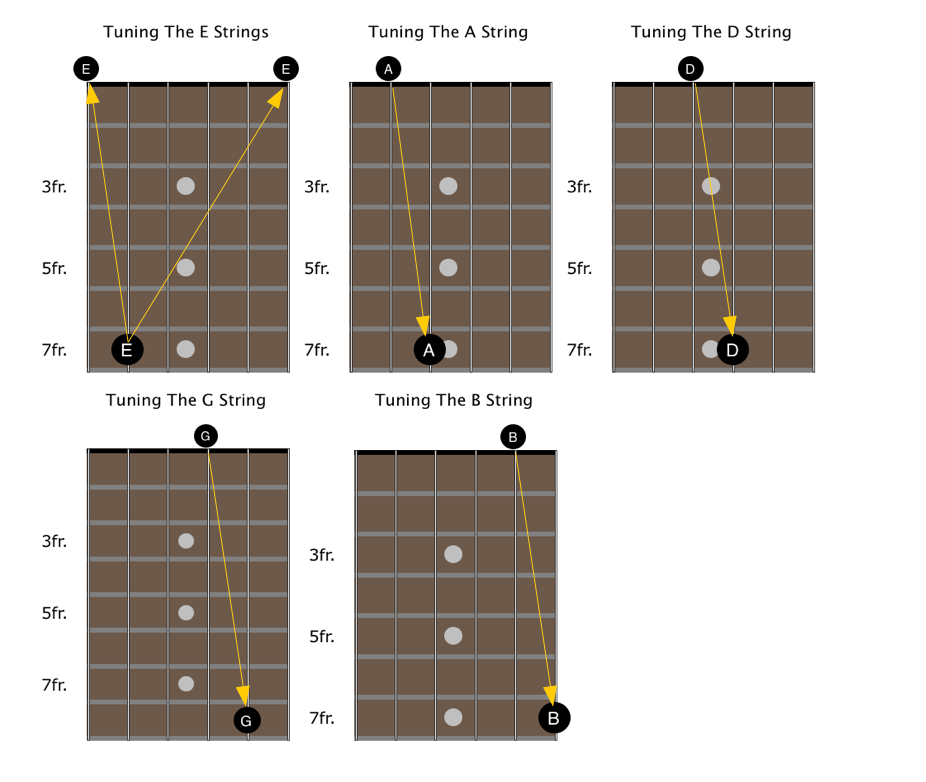
Method 3
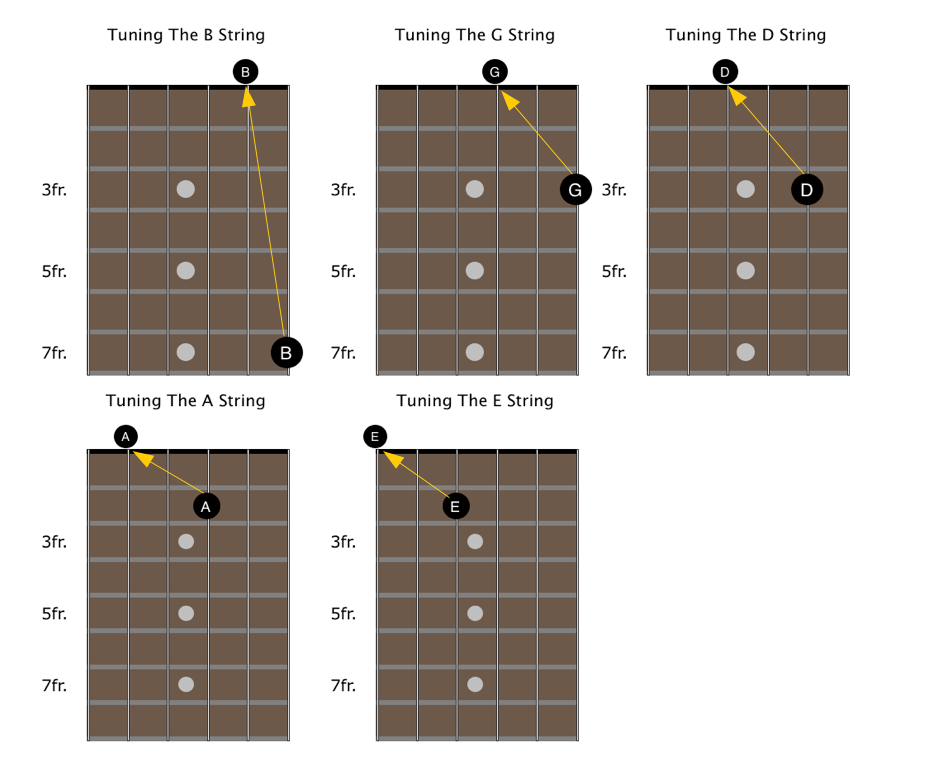
Fine Tuning With Chords
An effective method to use for fine-tuning is to check your tuning by playing a chord.
A chord uses multiple strings and allows you to listen for any tuning discrepancies in the intervals between the notes of a chosen chord.
After you’ve used one of the previous relative tuning methods choose a chord, preferably in the key of the music you plan on performing, pluck each string of the chord individually.
Pay close attention to any differences in pitch between the intervals and adjust any strings that are either too sharp or too flat.
If you’re right handed, hold the chord down with your left hand and reach over to adjust the tuning pegs with your right hand while the notes are still sounding.
It’s also important to play other chords up and down the neck to check different positions on the guitar due to the fact that the guitar is an even-tempered instrument as discussed above.
For example, if you’re performing in the key of C, perform a fine tuning by using an open C major chord, an A minor bar chord at the 5th fret, and an F major bar chord at the 8th fret.
A Moment Of Clarity: Harmonic’s Tuning Method
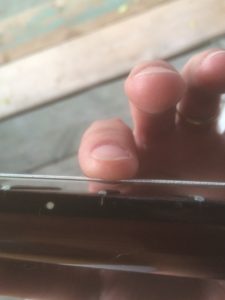
Harmonic notes can be used to check the tuning of the guitar as well.
Harmonics provide a purer tone than regular fretted notes, or open string notes, which makes it easier to hear any differences in pitch between the notes you’re tuning.
A harmonic note is performed on a guitar by just touching the string, not pressing down on the string, directly above the fret and then plucking the string as normal.
Although harmonics can be performed at many different spots along the fretboard, the easiest frets to use to produce a harmonic note are the 5th, 7th, and 12th frets.
Again, because the guitar is an even-tempered instrument, be aware that the harmonics produced on different strings may be slightly different from each other.
Because of this it would be good practice to use the harmonic’s tuning method in combination with some of the other tuning methods previously discussed.
Below is a diagram showing what harmonic notes the different frets will produce to use for checking your guitar’s tuning.
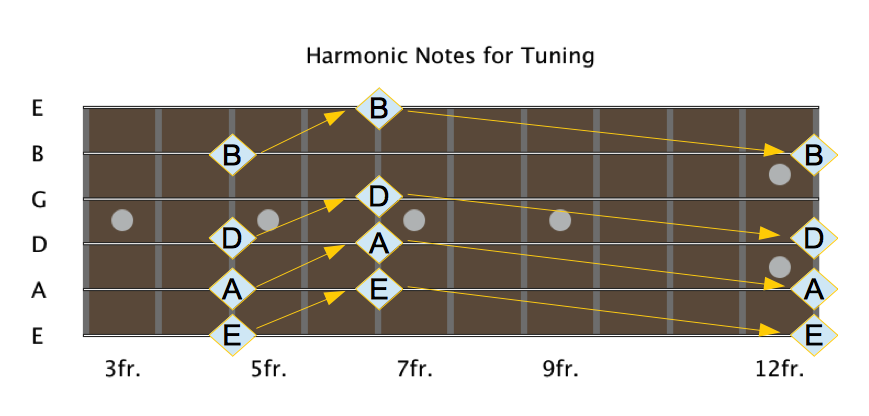
A New Perspective: Alternative Tunings
In addition to the standard method of tuning a guitar (from low to high: E A D G B E) there are a number of other ways the guitar can be tuned as well.
Below are some of the more common alternative tuning methods, but certainly not the only methods used to tune the guitar.
There’s a whole world of possibility when it comes to tuning the guitar in different ways and I encourage you to explore and discover your own ways of tuning the guitar.
Open Tunings
An open tuning is when the strings of the guitar are tuned so that a chord can be played using only the open strings.
The most common open tunings are Open G, Open D, Open E, and Open C.
| Tuning |
Open String Notes Low to High |
Diagram | Audio Example (Strings low to high) |
|---|---|---|---|
|
Open G |
D G D G B D |
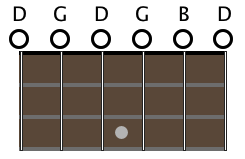 |
|
|
Open D |
D A D F# A D |
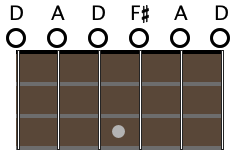 |
|
|
Open E |
E B E G# B E |
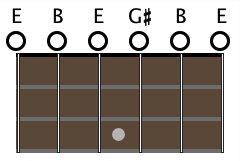 |
|
|
Open C |
C G C G C E |
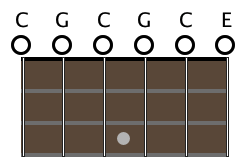 |
Cross-note Tunings
A cross-note tuning is just an open tuning in which the open-string chord is minor instead of major.
The difference is that the open string tuned to the major third of the chord is lowered by a half step, making the major chord a minor chord when all the open strings are strummed.
To play a major chord when using a cross-note tuning, all you need to do is play one fret higher on the string that was lowered by a half step.
For example, if using an Open D minor tuning, you’d play every string open except for the third string, F, which you play fretting the first fret to play a D major chord.
| Tuning |
Open String Notes Low to High |
Diagram | Audio Example (Strings low to high) |
|---|---|---|---|
|
Open D minor |
D A D F A D |
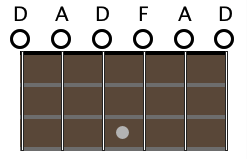 |
|
|
Open E minor |
E B E G B E |
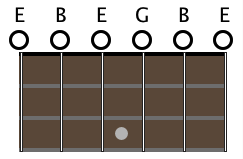 |
Modal Tunings
Modal tuning is another type of open tuning that sounds a suspended fourth chord when you play all the open strings together.
This means that the strings on the guitar would be tuned to give the 1st, 4th, and 5th notes of a certain root note’s major scale.
Below are a couple examples of this type of tuning in action.
|
Tuning |
Open String Notes Low to High |
Diagram |
Audio Example (Strings low to high) |
|---|---|---|---|
|
D Modal Tuning |
D A D G A D |
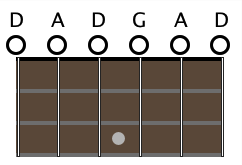 |
|
|
G Modal Tuning |
D G D G C D |
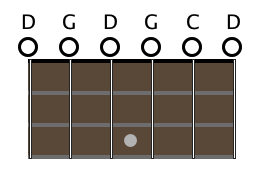 |
Dropped Tunings
A dropped tuning is when one or two strings are lowered in pitch. It’s the most common type of alternative tuning.
|
Tuning |
Open String Notes Low to High |
Diagram |
Audio Example (Strings low to high) |
|---|---|---|---|
|
Dropped D Tuning |
D A D G B E |
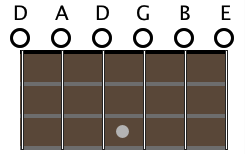 |
|
|
Dropped C Tuning |
C G C F A D |
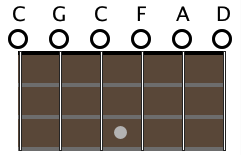 |
Miscellaneous Tunings
In addition to all of the previously mentioned tunings, there are many other ways you can tune the guitar.
Some of these other tunings are variations on other open tunings.
But, the options for guitar tunings are almost endless and many other ways of tuning the guitar can be discovered through experimentation.
|
Tuning |
Open String Notes Low to High |
Diagram |
Audio Example (Strings low to high) |
|---|---|---|---|
|
Miscellaneous 1 |
D A D F# B D |
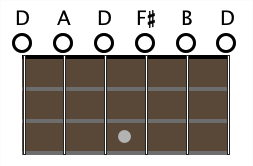 |
|
|
Miscellaneous 2 |
D A D G B D |
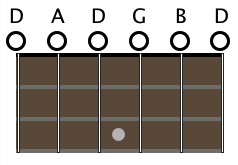 |
|
|
Miscellaneous 3 |
D A D E A E |
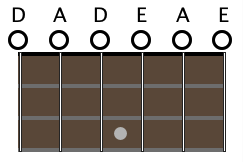 |
Relieving Your Frustrations: Tuning Tips
So now that you’ve spent some time making sure your guitar is perfectly in tune, it’s a good idea to make sure that it stays in tune to the best of its ability.
The best way to ensure that a guitar stays in tune, is to first understand the reasons why a guitar goes out of tune in the first place, and apply tools to keep those notes in place.
Below is a list as to why a guitar might not stay in tune and some tips to help confront these issues.
Un-stretched Strings
One of the main causes of guitar strings not staying in tune is from the strings not being properly stretched after installation.
Brand new strings have a fair amount of elasticity to them and the tension applied to them to keep them at a specific pitch will cause them to stretch.
This stretching, in turn, causes the tension to decrease and therefore the pitch to lower.
One way to battle this condition is to stretch the strings after installing them.
To stretch the strings, first tune them up to pitch, then grab the string with both hands a few inches apart and pull up with your fingers and push down with your thumbs.
Repeat this process all the way from the bridge up to the nut to ensure a good stretch.
You can also push down on the string outside of the playing area behind the nut and behind the bridge for a bit of string stretching insurance.
After you’ve done this, retune your strings up to pitch and repeat the process.
Improper String Installation
Another reason for strings not staying in tune is improper installation.
When installing strings, it’s important to make sure the strings are wrapped tightly and neatly around the tuning post.
For unwound strings, usually the high E, B, and G-strings, a good trick is to use a “locking tie.”
A locking tie is pulling the string through the tuning post, wrapping it around toward the centre of the headstock, then feeding it underneath the string where it enters the string post.
After this, the string should be held tightly against the post as the rest of the slack is tightened up, causing a nice tight grip against the tuning post.
For wound strings, low E, A, and D strings, run the string through the post and continue the winding downwards, keeping the windings tight and neat against the post.
When it comes to how much string to wind on, the main idea is to keep the angle from the tuning peg to the nut slot around 5 to 12 degrees.
Usually this works out to be about 3 to 5 wraps around the post.
String Contact Points, The Nut and Saddles
If the strings sit too deep in the nut, or if they’re getting pinched because the nut slot is too narrow, this can cause more tuning issues.
You’ll notice this when you are tuning and you hear a creaking sound as the string fights its way through the nut sot.
This can also cause the string to snap flat after bending a note. If the saddles of the string have a notch in them, be sure that this point of contact is also smooth and neat.
The idea is to not have any resistance at the two contact points of the string.
To help remedy any of these issues, you can apply a small amount of lubricant at the point of contact such as Vaseline or graphite from a pencil.
Tuning Heads
If your tuning heads are loose or slipping this will also cause tuning problems.
You can tighten the screw that fastens them to the guitar, but if this doesn’t work you might need to replace the faulty tuning head.
If you aren’t experienced with working on guitars, take your guitar to a professional to get this done.
High Frets
If your guitar is brand new, or you’ve just had it refretted, it may be difficult for you to play in tune.
This is because when a string hits the fret the correct note is sounded.
If you keep pressing the string down toward the fretboard, the note will continue to get sharper.
This becomes obvious when playing a chord and each finger is applying a different amount of pressure for each note of the chord, causing some notes to be sharper than others.
The Strap
If your strap is tied to the headstock of your guitar, it can put extra tension on the neck causing the strings to sound out of tune.
This is usually done because there is no strap button available on the body of the guitar for one end of the strap.
It’s a good idea to have another strap button installed if this is the case.
A couple popular spots to install a new strap button are on the heel of the guitar or on the guitar’s side close the heel of the neck.
I prefer a strap button on the side of the guitar as this tends to balance the guitar well and is out of the way of the fretting hand.
Again, if you don’t feel comfortable performing work on the guitar yourself, I would recommend bringing your guitar to a professional for the installation.
Condition of Strings
Old, dirty, or rusty strings will have a lot of trouble staying in tune. To remedy this, I recommend replacing your strings.
Be aware that time isn’t necessarily the best indicator of whether or not you should replace your strings.
It’s important to actually check the condition of your strings.
If your hands tend to sweat more than others, the quality of the stings will decrease much quicker and you will probably encounter tuning issues more often due to rusty strings.
To avoid problems, wipe your strings down after playing to make them last longer. A lint-free cloth or even just an old T-shirt works well for this.
Intonation
Sometimes when you play an open chord, such as a G Major, it’ll sound perfectly in tune.
But, when you play a G Major barre chord at the 10th fret it sounds awfully out of tune. This is a result of the guitar’s intonation.
A guitar is said to have correct intonation when it produces the correct pitch at every fret on a string, when the open strings are tuned to concert pitch.
When fretting notes on a guitar, they become slightly sharp as a result of the distance and pressure applied from pressing down on the string while playing.
This’ll be much worse on a guitar with higher action. Setting a guitar’s intonation is the process of compensating for these string-length inefficiencies.
This is achieved by increasing the string-length by adjusting the bridge saddles to compensate for the sharpness produced from pressing down the strings when fretting.
The string-length or scale is the distance from the nut to the centre of the saddle. The distance from the nut to the 12th fret is the halfway point of the guitar’s scale.
One method to intonate the guitar is to get the guitar to play the same note an octave higher at the 12th fret as the open string.
Most acoustic guitars will compensate for string-length inefficiencies by angling the bridge saddle in a way where the bass strings have a longer scale than the treble strings.
Most electric guitars have adjustable bridge saddles to allow you to perform the intonation yourself.
How To Remember Different Tunings
With all the different tunings available, you might find it a bit overwhelming trying to remember how each string is tuned in a given tuning.
One tool that I’ve found to be quite useful is to come up with a saying to help remember what notes to tune the open strings to for some of the more common tunings.
Below is a table of some common tunings and corresponding sayings using the notes of the open strings of each tuning to get you started.
|
Tuning |
Open String Notes |
Saying |
|---|---|---|
|
Standard |
E A D G B E |
Eddy Ate Dynamite Good Bye Eddy |
|
Drop D |
D A D G B E |
Don’t Always Do Good By Everyone |

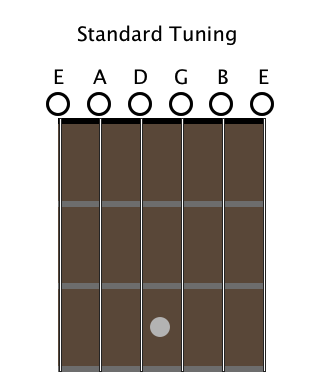
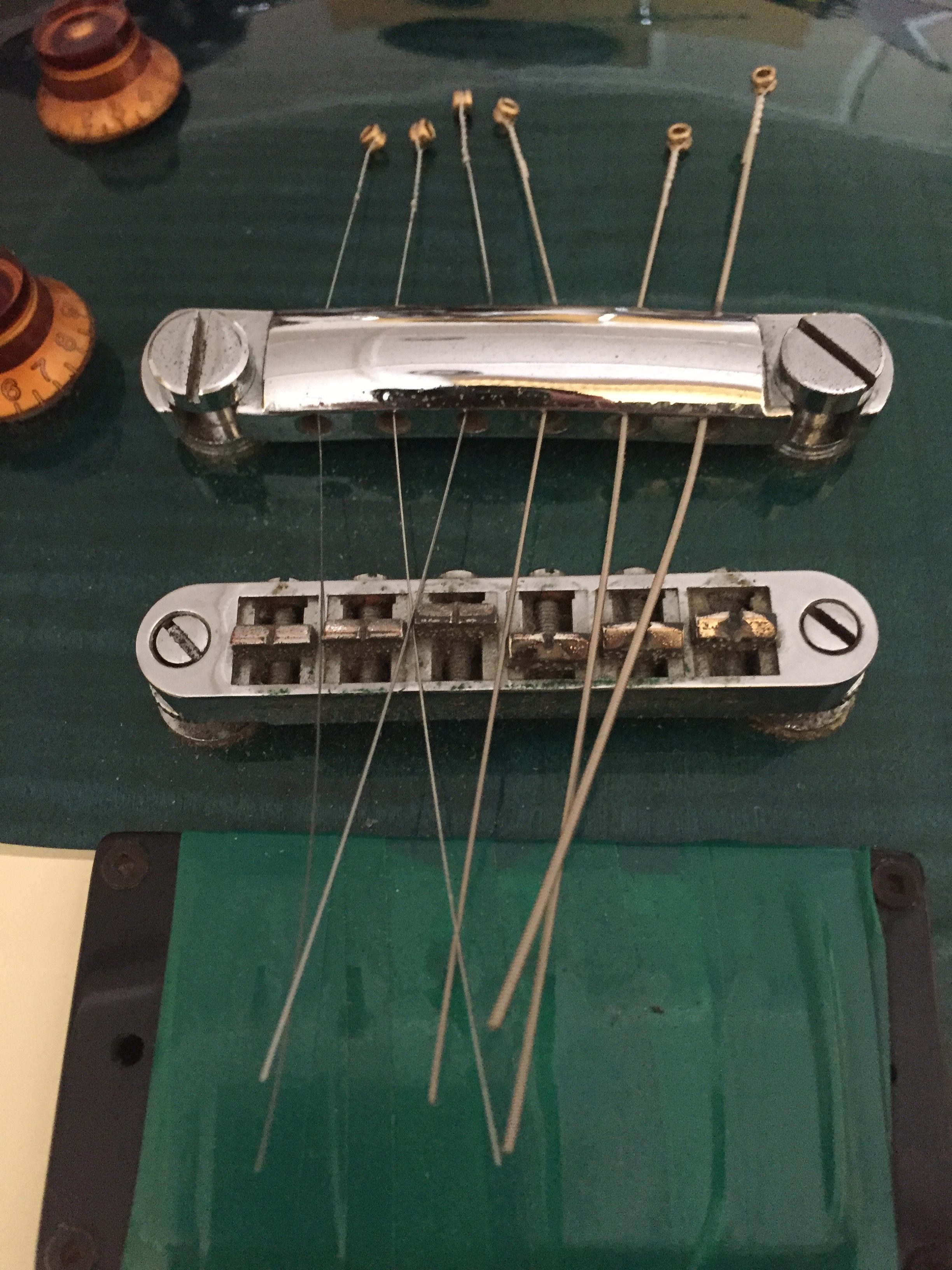
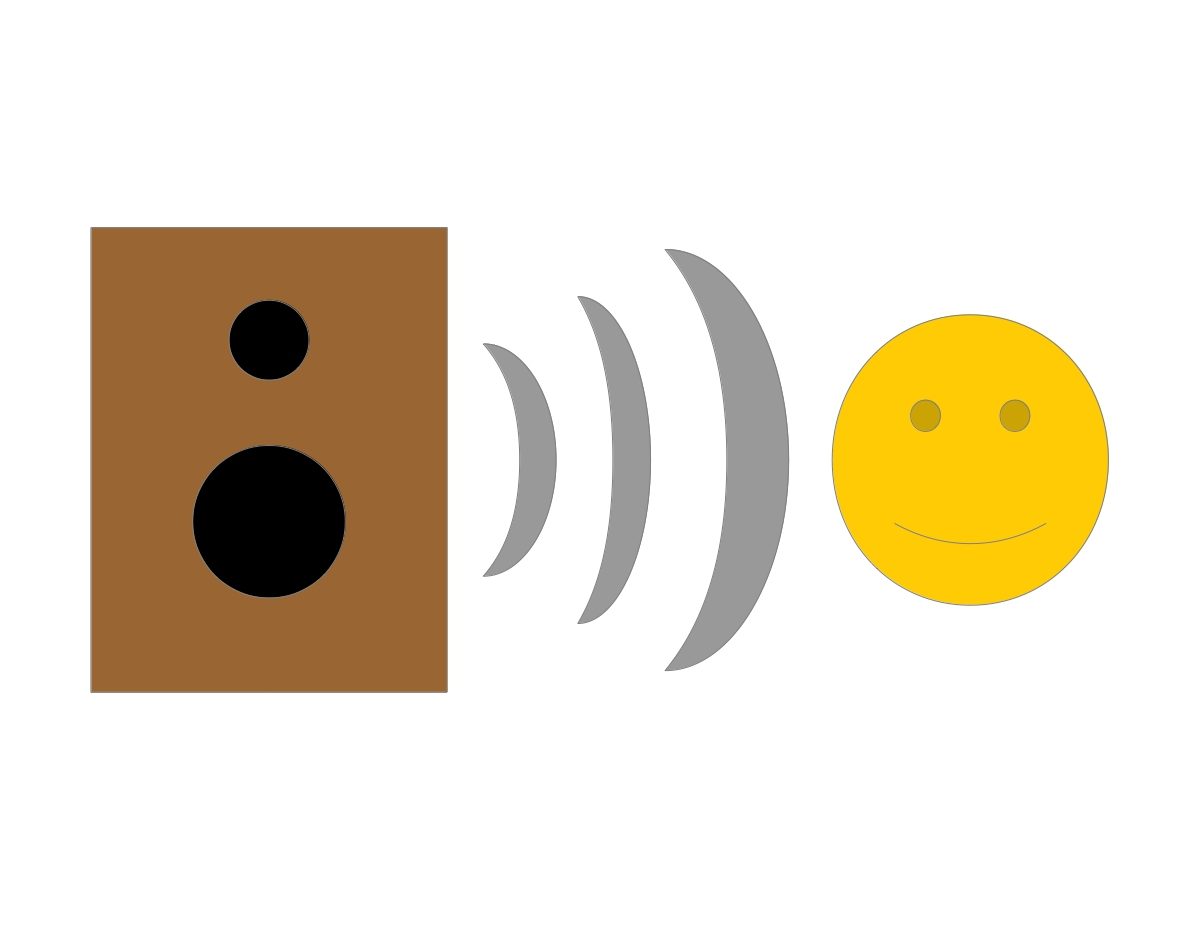
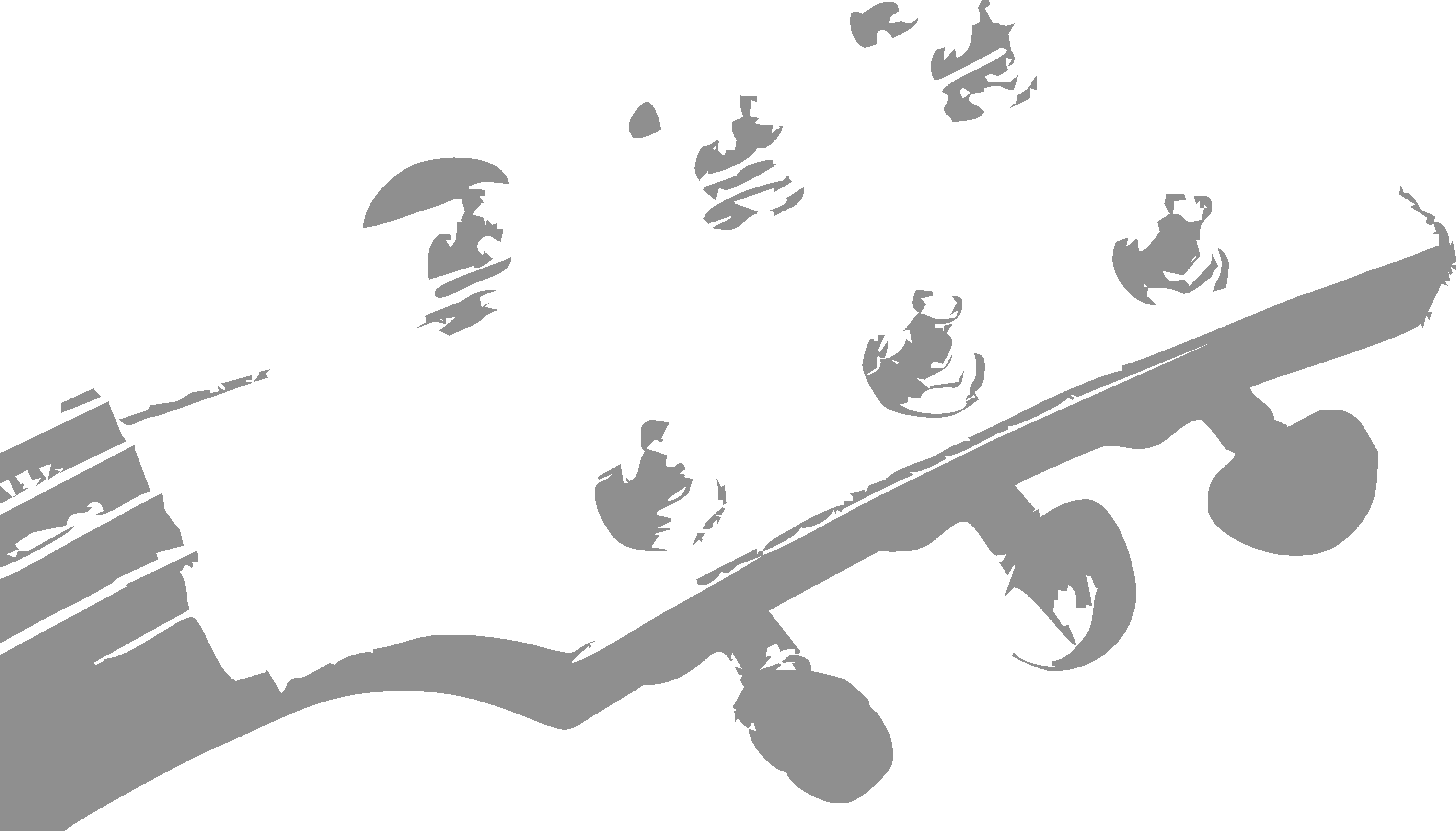
2 Comments
This is a most useful guide, especially for beginners. I’ve played the guitar since 1977, but I now know a few more tips, thanks to these notes.
Cheers,
Rod Bruce
Thanks Rod, I’m glad you found something useful in the guide!